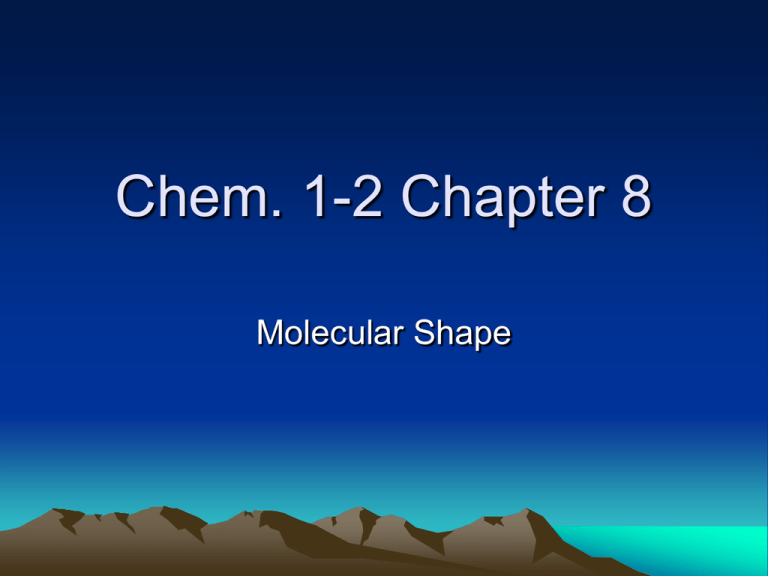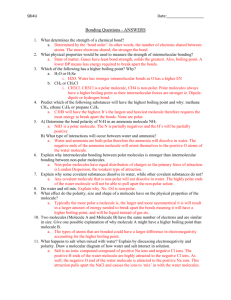- U
advertisement

Chem. 1-2 Chapter 8 Molecular Shape Formulas • Molecular Formula: – Specifies how many atoms are in a single molecule of a compound: – Ex. Glucose is C6H12O6 • Empirical Formula: – Specifies the ratios in which molecules are present. – Ex. Glucose empirical formula is C3H6O3 – You simply divide until a subscript cannot be divided by a whole number Formulas….. • Structural Formula: – Shows the arrangement of atoms in a molecule… The Lewis structures you have been doing. • However, structural formulas don’t give information on the shape of the molecule. • This information is often shown with ball and stick models Shapes • Shapes are most often symmetrical. • Why? • Valence electrons will arrange themselves as far away from each other as possible. This is called the Valence-Shell Electron Pair Repulsion Theory (VSEPR) – Exceptions to this are molecules involving transition metals. • There are five main shapes of molecules Linear • A straight line. • All molecules with only 2 atoms. • But CO2 is too….. – This is because the valence electrons try to get as far away from each other as possible. – No unshared central electrons. • Bond angle is 180° Trigonal Planar • “Triangular laid out flat” • Example BCl3 • Generally when a central atom has 3 surrounding atoms AND the central atom has no unshared pairs of electrons. • Bond angle is 120° Tetrahedral • “4 surfaced shape” • Ex. CH4 • It is like a pyramid with a flagpole on the top. • It is not a flat shape because the electrons can be further apart (at an angle of 109.5°) using a 3D spread instead of 90° as a flat shape. Pyramidal • Specifically a 3-sided base (not like the Egyptian pyramids) • When we have a central atom with unshared electron surrounded by 3 other atoms. • Ex. NH3 • Bond angle is 107° • Unshared pairs repel stronger than bond pairs Bent • Example : H2O • Again, the unshared pairs exert a greater repulsion force. So the 2 H atoms are separated by a slightly smaller angle than one would expect. • Bond angle is 105° Home work • Write the Structural Formula (Lewis Structure) and predict/draw the shape of the following molecules: • CCl4, HCN, BF3, BeCl2, H2S, NF3, PCl3, OF2, SiO2, CF4 • Due Tomorrow Bond Length • The distance between nucleii of atoms in a molecule. • Two trends…. – Triple bonds are shorter than double bonds which are shorter than single bonds. – As you move down a group, atoms are _________, therefore bond length is _______ Polarity • Polar molecules remember from ch 7? • Polar molecules form Dipoles, meaning two poles – the molecule has a negative and a positive end. • If a molecule has only non-polar (less than 0.4 E.N. difference) bonds it is a non-polar molecule. • Strangely, if a molecule contains polar bonds, it is not necessarily polar. If symmetry cancels out the polarity, the molecule is non-polar. Polarity…. • The shape of a molecule AND the polarity of its bonds determine molecule polarity. • We must look again at electronegativity… the ability of an atom to attract electrons in bonds. • Remember, electronegativity increases going left to right in a period. • Electronegativity increases going up a group. • See table on page 241 Why is polarity important? • Polar molecules only dissolve polar molecules • Non-polar molecules only dissolve nonpolar molecules. How do we figure out if a molecule is polar? • Draw ball and stick model. • Look at the electronegativity difference between each atom involved in a bond. • Draw arrows in the direction of highest E.N. on each bond. • The length of each arrow is proportional to the E.N. difference across each bond. • Imagine the arrows show an electron tug of war…. • If the tug-of-war is a draw, the molecule is non-polar. There is symmetry of electronegativity. • If there is not good symmetry, the molecule is polar. Polarity …. • Lets take the examples of H2CO, CO2 and H2O.











